
Cactus Around Las Vegas, Vegetation Around Las Vegas
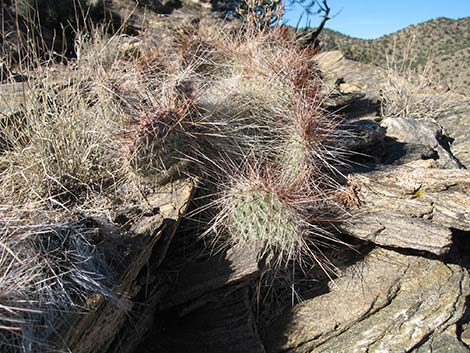 |
General: Pricklypear Cactus is the general name for a class of cactus in the genus Opuntia with broad, pad-like stems. In places, pricklypear are abundant or dominant components of the vegetation community, especially where the land is overgrazed by cattle, which tend to avoid the spiny pads. Pricklypear generally occur in Lower Sonoran (Creosote-Bursage Flats) and Upper Sonoran (Mojave Desert Scrub and Pinyon-Juniper Woodland) life zones, but some species grow in the higher life zones. Several species occur around Las Vegas. Family: Cactus (Cactaceae). Other Names: Each species seems to have several common names. Plant Form: Spreading or upright. Pads flat, round to oval, succulent. Pads emerge from the ground or from other pads to form short, upright stems. Height: To 2-3 feet. Trunk: None, per se, but the fleshy pads form upright stems. |
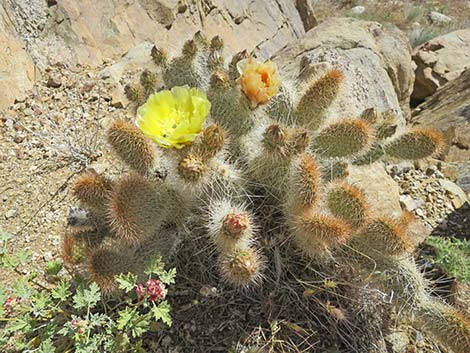 |
Leaves: None (reduced to spines). Flowers: Large, yellow or red flowers; blooms in late spring. Seeds: Grow from seeds and from broken pads that fall on the ground. Habitat: Rocky bajadas to desert peaks, depending on the species. Distribution: Various species are distributed throughout the southwestern deserts. Elevation: 1,000 to 8,000 ft. Comments: Desert Woodrats (Neotoma lepida) eat the pads, often working around the spines. Cattle will eat the pads if the spines are burned off. Many species of wildlife and native peoples eat the sweet, pear-shaped purple fruit and black seeds. |
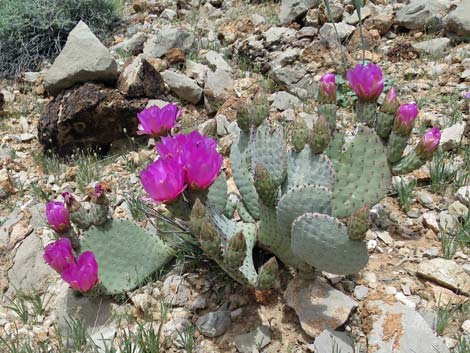 |
Beavertail Cactus (Opuntia basilaris). Large pads (5-7 in long) without obvious spines. Although Beavertail Cactus look like they have no spines, picking up a loose pad will quickly convince you of your mistake. They have tiny, hair-like spines at are quite irritating and difficult to remove. |
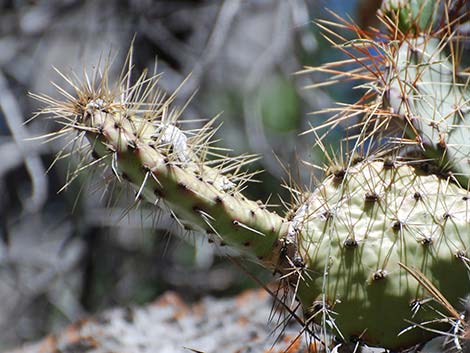 |
Charleston Mountain Pricklypear (Opuntia charlestonensis). This rare species only occurs in forests at higher elevations (about 8,000 ft) in the Canadian (Pine-Fir Forest) life zone in the Spring Mountains. |
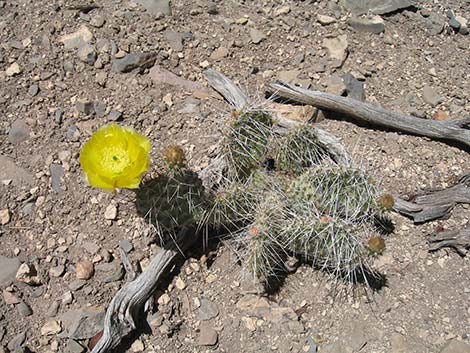 |
Hairspine Cactus (Opuntia polyacantha var. polyacantha) is a low-growing cactus with broad, thin stem segments (pads). The pads are medium-sized for a pricklypear (to about 5-inches long by 3-inches wide). The spines are clustered, relatively short (to about 3 inches), and straight. Often there are no spines at the base of the pad. |
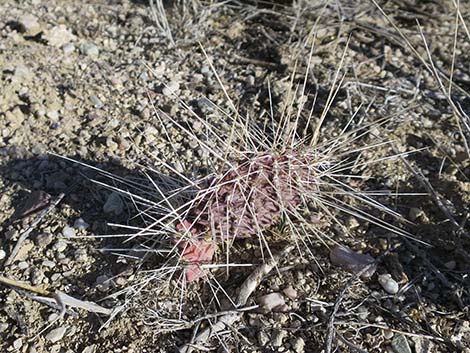 |
Porcupine Pricklypear (Opuntia polyacantha var. hystricina) is a low-growing cactus with broad, thin stem segments (pads). The pads are medium-sized for a pricklypear (to about 5-inches long by 3-inches wide). The spines are clustered, long (to about 4-5 inches), and straight, usually dark colored (brown to black). This is mostly a Utah variety with the range stretching south through the Utah-Colorado-Arizona-New Mexico border region, plus a tongue of population reaching into east-central Nevada. |
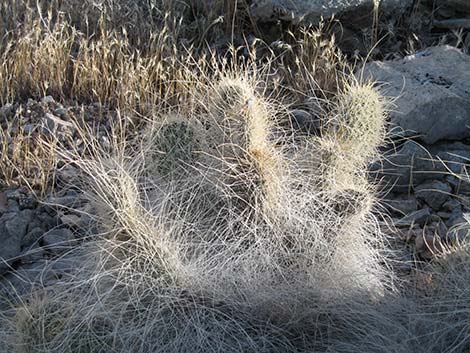 |
Grizzlybear Cactus (Opuntia polyacantha var. erinacea). Small pads (3-4 inches). Spines variable, but usually very long (to 6 in), flexible, and flowing such that the spines look like long gray hairs. |
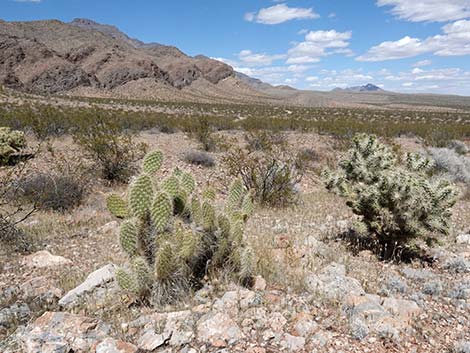 |
Western Pricklypear Cactus (Opuntia diploursina). This is an upright, tall (to 2 ft) pricklypear with upright growing, oblong pads. Spine clusters on the pads are many and packed close together. Usually there are several small spines and one long spine per cluster. The longer spines often exceed 2 inches, but they can grow quite long. The flowers usually are yellow, but can be pink to red. The fruit is a dry, spiny bur. |
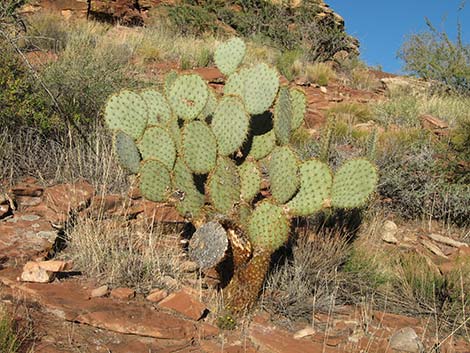 |
Pancake Pricklypear (Opuntia chlorotica). Large, broad, very round pads. Grows upright and tree-like with a large "trunk" and branches of pricklypear pads. The pads are nearly round and the spines are stout. |
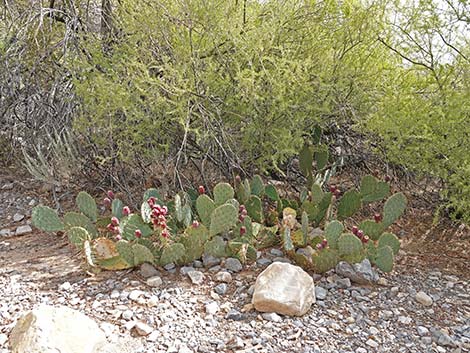 |
Tulip Pricklypear (Opuntia phaeacantha). A low-growing, spreading cactus with flat stem segments (pads). The pads are relatively long and broad, and the spines are usually confined to the upper 70% of the pads. Areoles (where the spines originate) usually spread about 3/4-inch apart, and areoles without spines can be seen at the base of each pad. Spines typically long near the top of the pad and shorter lower down; longer spines gray with reddish base, flattened; shorter spines all gray. Glochids absent on the side of the pads. Flowers yellow, usually with red at the base of the petals. Fruit is a fleshy "cactus apple" with a green interior.` |
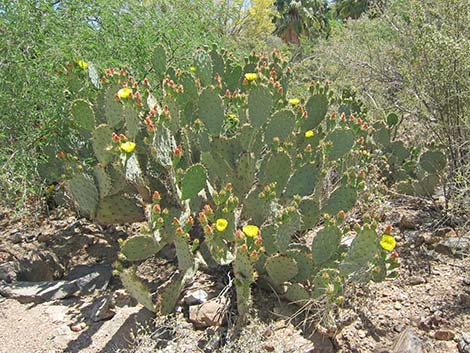 |
Cactus Apple Pricklypear (Opuntia engelmannii) is a mound-shaped cactus with spreading lower stems and upright upper stems. The stem segments are flat pads that are 10-12 inches long and oval in shape. All areoles have 3-12 spines, the longest of which are about 2-inches long, more-or-less flat, and yellow. Flowers yellow. Fruit is a fleshy "cactus apple" with a red interior. |
Note: All distances, elevations, and other facts are approximate. Names generally follow the USDA database.
![]() ; Last updated 240902
; Last updated 240902
| All Cactus | Plant Species Index | Glossary | Copyright, Conditions, Disclaimer | Home |